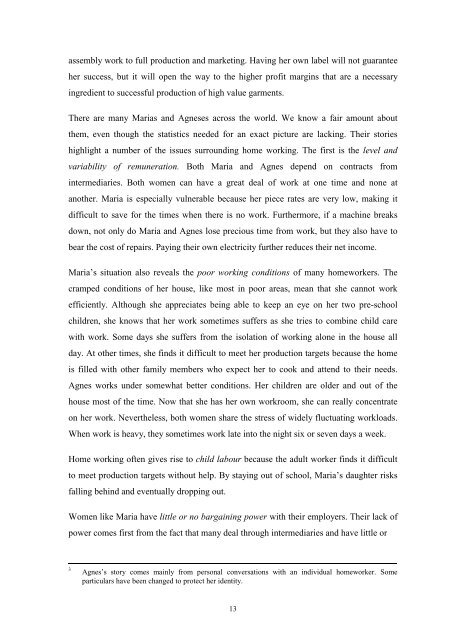McCormick+Schmitz Handbook for value chain research on - PACA
McCormick+Schmitz Handbook for value chain research on - PACA
McCormick+Schmitz Handbook for value chain research on - PACA
You also want an ePaper? Increase the reach of your titles
YUMPU automatically turns print PDFs into web optimized ePapers that Google loves.
assembly work to full producti<strong>on</strong> and marketing. Having her own label will not guarantee<br />
her success, but it will open the way to the higher profit margins that are a necessary<br />
ingredient to successful producti<strong>on</strong> of high <str<strong>on</strong>g>value</str<strong>on</strong>g> garments.<br />
There are many Marias and Agneses across the world. We know a fair amount about<br />
them, even though the statistics needed <str<strong>on</strong>g>for</str<strong>on</strong>g> an exact picture are lacking. Their stories<br />
highlight a number of the issues surrounding home working. The first is the level and<br />
variability of remunerati<strong>on</strong>. Both Maria and Agnes depend <strong>on</strong> c<strong>on</strong>tracts from<br />
intermediaries. Both women can have a great deal of work at <strong>on</strong>e time and n<strong>on</strong>e at<br />
another. Maria is especially vulnerable because her piece rates are very low, making it<br />
difficult to save <str<strong>on</strong>g>for</str<strong>on</strong>g> the times when there is no work. Furthermore, if a machine breaks<br />
down, not <strong>on</strong>ly do Maria and Agnes lose precious time from work, but they also have to<br />
bear the cost of repairs. Paying their own electricity further reduces their net income.<br />
Maria’s situati<strong>on</strong> also reveals the poor working c<strong>on</strong>diti<strong>on</strong>s of many homeworkers. The<br />
cramped c<strong>on</strong>diti<strong>on</strong>s of her house, like most in poor areas, mean that she cannot work<br />
efficiently. Although she appreciates being able to keep an eye <strong>on</strong> her two pre-school<br />
children, she knows that her work sometimes suffers as she tries to combine child care<br />
with work. Some days she suffers from the isolati<strong>on</strong> of working al<strong>on</strong>e in the house all<br />
day. At other times, she finds it difficult to meet her producti<strong>on</strong> targets because the home<br />
is filled with other family members who expect her to cook and attend to their needs.<br />
Agnes works under somewhat better c<strong>on</strong>diti<strong>on</strong>s. Her children are older and out of the<br />
house most of the time. Now that she has her own workroom, she can really c<strong>on</strong>centrate<br />
<strong>on</strong> her work. Nevertheless, both women share the stress of widely fluctuating workloads.<br />
When work is heavy, they sometimes work late into the night six or seven days a week.<br />
Home working often gives rise to child labour because the adult worker finds it difficult<br />
to meet producti<strong>on</strong> targets without help. By staying out of school, Maria’s daughter risks<br />
falling behind and eventually dropping out.<br />
Women like Maria have little or no bargaining power with their employers. Their lack of<br />
power comes first from the fact that many deal through intermediaries and have little or<br />
3<br />
Agnes’s story comes mainly from pers<strong>on</strong>al c<strong>on</strong>versati<strong>on</strong>s with an individual homeworker. Some<br />
particulars have been changed to protect her identity.<br />
13














